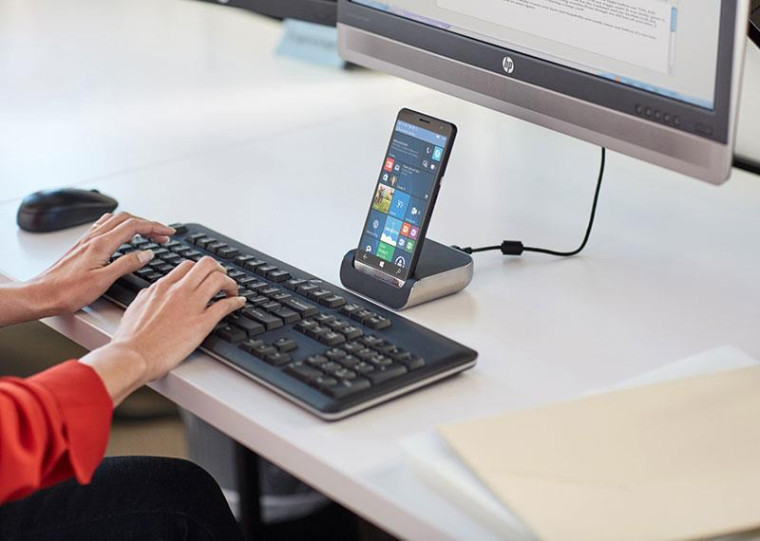
Microsoft's mobile business has been declining for some time now. In its latest earnings report, the company revealed that the quarterly revenue from its phone hardware division had dropped to just $300 million, down from $2.6 billion two years earlier. Its current range of Windows 10 Mobile devices has done little to inspire buyers - but as its current flagships approach the end of their retail lives, one of their most important features lives on in other premium Windows phones launched by some of Microsoft's partners.
Continuum is a defining feature of the Windows 10 Mobile proposition. It allows owners of high-end handsets to use a mouse and keyboard with their device when connected to a larger display, either wirelessly or via a wired docking station. That's precisely why Acer described its Windows 10 Mobile flagship as a 'pocket PC'; in Continuum mode, a phone becomes much more like a PC, including a desktop-style interface and Start menu.
From smaller companies like NuAns and Coship, to better known brands like Alcatel and VAIO, numerous manufacturers have now embraced Microsoft's Continuum vision with premium Windows 10 Mobile handsets of their own. HP has been particularly enthusiastic about Continuum with its Elite x3 flagship, designing its own Desk Dock, as well as a notebook-style Lap Dock that enables owners to use their phones as a PC on the move. While Acer uses the 'pocket PC' descriptor, HP goes even further, referring to the Elite x3 as a '3-in-1 device'.

But Continuum isn't perfect.
First, there's the software. Older Windows Phone apps can't run in Continuum mode - instead, you're limited to newer Universal Windows Platform (UWP) apps downloaded from the Windows Store. Some Windows Store apps - those which have been converted from Win32 or .NET using the Desktop App Converter - aren't compatible with the ARM processors of Windows 10 Mobile devices either. 'Pocket PC' is a nice turn of phrase, but Windows 10 Mobile phones can't run any software designed for x86 systems, thereby excluding many of the older applications that people are accustomed to using on their Windows desktop PCs and notebooks.
HP is getting around that limitation through virtualization, using its cloud capabilities to stream x86 applications to its Elite x3 handset. But that functionality is targeted exclusively at businesses, with a minimum cost of $579 per user per year.

Indeed, cost is another issue with the Continuum proposition. The Elite x3 costs $799 with the Desk Dock, but mouse, keyboard and monitor are sold separately. If you want to use Continuum on the go, that will set you back a further $599 for the Lap Dock. More affordable options are available - Acer's year-old Liquid Jade Primo is now available for $449 including a desktop dock, mouse and keyboard, but there's still no sign of the Lap Dock-style 'Mobile Extender' that the company showed off seven months ago.
And there's also the question of convenience. On paper, it sounds very handy to have one device that can act as your phone, laptop and PC - but the reality appears less convenient. Do you carry the phone, mouse, keyboard and dock with you wherever you go, connecting it all up when you get to work, home or your hotel? Do you have a dock at home, a dock at work, and a laptop dock when you're on the move? Given the software limitations, is any of that really more convenient than just having a smartphone, a fully capable laptop, and/or a desktop, that can run all of the software you might want to use?

Of course, there's no denying that Continuum is a 'version 1.0' product, and it would be very easy to write it off as limited, costly or cumbersome - but it's not hard to imagine how it could be developed in the future into a much more complete offering.
As we discussed in a feature article last year, despite Microsoft's struggles in the smartphone market, it's clearly aware that mobile computing is the future, and with the advent of increasingly powerful technology, that future may well bring us a single device to replace our smartphones, notebooks, desktops, and even consoles.
Microsoft has already promised more improvements to Continuum - designed to make the experience even more 'PC-like', and which will arrive in its Windows 10 Mobile Creators Update early next year - and the company no doubt has further enhancements planned beyond that.
Perhaps, then, the limitations of Continuum today should be viewed as a necessary first step towards that more capable future. Perhaps you've already decided that it's a pointless feature, and that separate devices make more sense. Or perhaps you've found that Continuum perfectly suits your requirements, and you're simply looking forward to what comes next.
We're very eager to hear your thoughts on this, so please share them with us below!

















49 Comments - Add comment